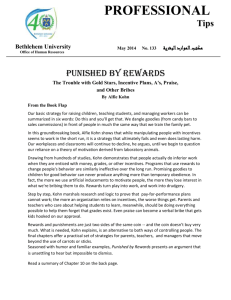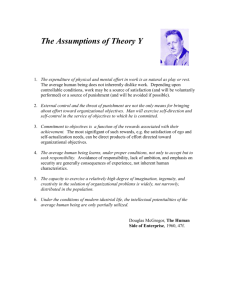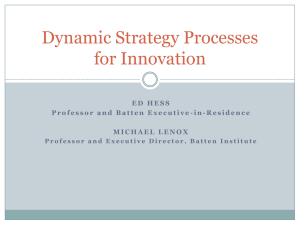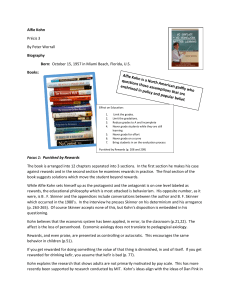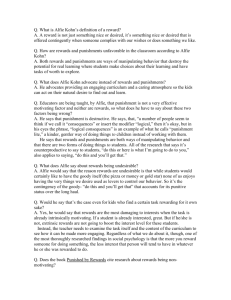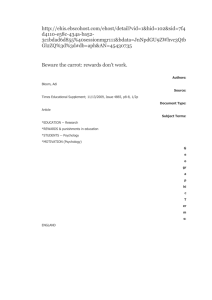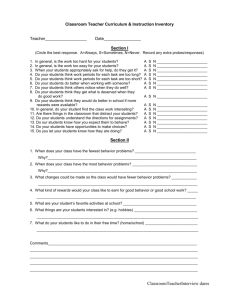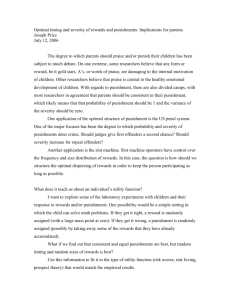Punished by Rewards
advertisement
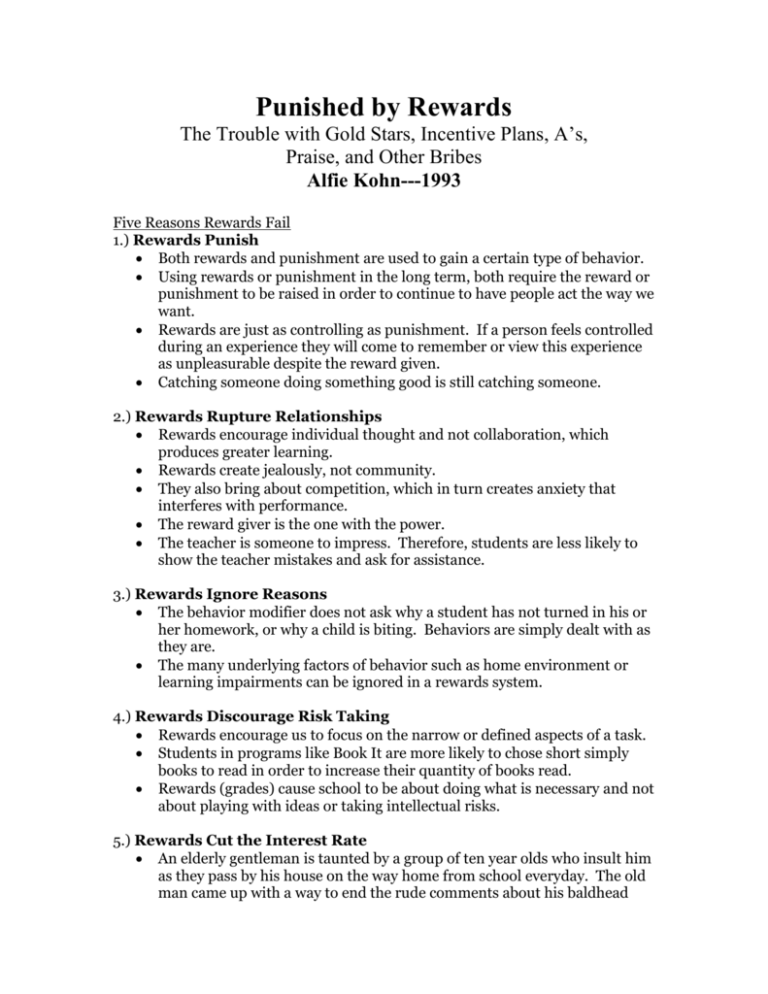
Punished by Rewards The Trouble with Gold Stars, Incentive Plans, A’s, Praise, and Other Bribes Alfie Kohn---1993 Five Reasons Rewards Fail 1.) Rewards Punish Both rewards and punishment are used to gain a certain type of behavior. Using rewards or punishment in the long term, both require the reward or punishment to be raised in order to continue to have people act the way we want. Rewards are just as controlling as punishment. If a person feels controlled during an experience they will come to remember or view this experience as unpleasurable despite the reward given. Catching someone doing something good is still catching someone. 2.) Rewards Rupture Relationships Rewards encourage individual thought and not collaboration, which produces greater learning. Rewards create jealously, not community. They also bring about competition, which in turn creates anxiety that interferes with performance. The reward giver is the one with the power. The teacher is someone to impress. Therefore, students are less likely to show the teacher mistakes and ask for assistance. 3.) Rewards Ignore Reasons The behavior modifier does not ask why a student has not turned in his or her homework, or why a child is biting. Behaviors are simply dealt with as they are. The many underlying factors of behavior such as home environment or learning impairments can be ignored in a rewards system. 4.) Rewards Discourage Risk Taking Rewards encourage us to focus on the narrow or defined aspects of a task. Students in programs like Book It are more likely to chose short simply books to read in order to increase their quantity of books read. Rewards (grades) cause school to be about doing what is necessary and not about playing with ideas or taking intellectual risks. 5.) Rewards Cut the Interest Rate An elderly gentleman is taunted by a group of ten year olds who insult him as they pass by his house on the way home from school everyday. The old man came up with a way to end the rude comments about his baldhead and sagging stomach. On Monday afternoon he met them on his lawn as they passed by. He said, “Anyone who comes by tomorrow to insult me will receive a dollar. So on Tuesday the children showed up even earlier to harass the old man. True to his word he gave them a dollar. Then he said, “If you come by tomorrow and do the same thing I will give you 25 cents.” So on Wednesday the same thing happened. He told them that from now on he would only pay a penny to be insulted. The kids decided that a penny was not worth the effort they were putting in and never came back again. Preparation H Grading has created “grade grubbers.” Students are so preoccupied with getting a good grade they forget that they are in school to learn. Alfie talks about students focusing their entire childhood on getting into Harvard, (what Alfie calls preparation H). Striving for the best grade does not end once students enter college, or even after they graduate. There is always the next set of rewards to work towards. When he presented this information to students a prestigious prep school, one student asked, “But what else is there?” Alfie says it was not a question to be answered. Solutions With all this criticism of reward systems, what is Alfie Kohn’s solution to the system of rewards so deeply rooted in our society? Well, he can’t just give one answer. He says, “I have found it frustrating and difficult to answer for several reasons.” (179) The alternative to rewards depends on who you are talking about, employees, students, or one’s own children. We must also consider the cause of the problem we are trying to correct and our objective trying to be attained. Unlike pop-behaviorism, Alfie says, there is not one answer to fit all situations. Instead he gives different goals for employers, teachers, and parents. Below are some tips for teachers. Alfie Kohn’s first suggestion to get students “hooked on learning” is to remover rewards all together. Children do not need stickers or candy to get them excited about learning because they are naturally curious. Teachers need to set up an environment that is interesting with many authentic choices. Removing rewards from schools will not be an easy task considering so many students are addicted to A’s or stickers. Students must be involved in the change over and guided by the teacher to see reasons for which people learn. Given Alfie Kohn’s distaste for rewards and seeing as how grades are a type of reward, he suggests getting rid of our current grading systems because grades undermine intrinsic motivation. Instead, grades should be replaced with comments that tell a student what he or she did well and what he or she needs to work on. Another reason to do away with grades is that a classroom that feels safe to students is one in which they are free to admit when they do not understand something and are able to ask for questions. The teacher is more of a collaborator than judge. If one must grade students’ work, there are 7 guidelines for doing so. 1. Limit the number of assignments graded. 2. Limit the number of gradations in the grading scale. Go from a A/B/C/D scale to a check, check plus, check minus scale. 3. Or, just give A’s and Incomplete. Work is not completed until a student has mastered the skill given on an assignment. Once it is mastered then the student should receive an A. 4. Never grade while students are still learning material. 5. Never grade for effort. This actually reduces the effort put into an assignment. 6. Never grade on a curve. This puts students up against one another and artificially limits the number of successes available. 7. Bring students in on their own evaluation. Alfie Kohn supports Bruner’s idea of discovery learning. He has five suggestions for supporting discovery learning. 1. Allow for active learning. Hands on activities are more effective learning tools. 2. State the reason why students are learning something. If a lesson is valuable tell the students why it is so. 3. Elicit their curiosity. 4. Set an example. A teacher must let students hear him or her talk about what they get excited about or enjoy learning. 5. Welcome mistakes. Alfie Kohn’s 3 C’s Collaboration- Learning together Content- Things worth knowing Choice- Autonomy in the classroom These three things go together to make up an Alfie Kohn classroom with the good signs given below. What to Look For in a Classroom From The Schools Our Children Deserve GOOD SIGNS FURNITURE Chairs around tables to facilitate interaction Comfortable areas for learning, including multiple "activity POSSIBLE REASONS TO WORRY Chairs all facing forward or (even worse) desks in rows centers" Open space for gathering ON THE WALLS Covered with students’ projects Nothing Commercial posters Evidence of student collaboration Signs, exhibits, or lists obviously created by students rather than by the teacher Information about, and personal mementos of, the people who spend time together in this classroom Students’ assignments displayed, but they are (a) suspiciously flawless, (b) only from "the best" students, or (c) virtually all alike List of rules created by an adult and/or list of punitive consequences for misbehavior Sticker (or star) chart -or other evidence that students are rewarded or ranked STUDENTS’ FACES Eager, engaged Blank, bored SOUNDS Frequent hum of activity and ideas being exchanged Frequent periods of silence The teacher’s voice is the loudest or most often heard LOCATION OF TEACHER Typically working with students so it takes a few seconds to find her Typically front and center TEACHER’S VOICE Respectful, genuine, warm Controlling and imperious Condescending and saccharine-sweet STUDENTS’ REACTION TO VISITOR Welcoming; eager to explain or demonstrate what they’re doing or to Either unresponsive or hoping to be distracted from what they’re doing use visitor as a resource CLASS Students often address DISCUSSION one another directly Emphasis on thoughtful exploration of complicated issues Students ask questions at least as often the teacher does All exchanges involve (or are directed by) the teacher; students wait to be called on Emphasis on facts and right answers Students race to be first to answer teacher’s "Who can tell me…?" queries STUFF Room overflowing with good books, art supplies, animals and plants, science apparatus; "sense of purposeful clutter" Textbooks, worksheets, and other packaged instructional materials predominate; sense of enforced orderliness TASKS Different activities often take place simultaneously All students usually doing the same thing Activities frequently completed by pairs or groups of students AROUND THE SCHOOL Appealing atmosphere: a place where people would want to spend time When students aren’t listening to the teacher, they’re working alone Stark, institutional feel Awards, trophies, and prizes displayed, suggesting an emphasis Students’ projects fill the on triumph rather than hallways community Library well-stocked and comfortable Bathrooms in good condition Faculty lounge warm and inviting Office staff welcoming toward visitors and students Students helping in lunchroom, library, and with other school functions
